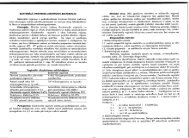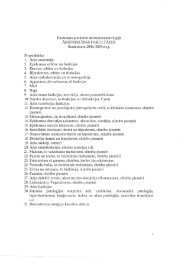PHYSICS
n - susliks.lv
n - susliks.lv
- No tags were found...
Create successful ePaper yourself
Turn your PDF publications into a flip-book with our unique Google optimized e-Paper software.
Continuation of Table 13.2<br />
Hydrogen 0.172 20<br />
Nitrogen 0.0234 20<br />
Oxygen 0.0238 20<br />
Nonmetals<br />
Water 0.565 0<br />
» 0.599 20<br />
» 0.627 40<br />
Concrete 2.43 20<br />
Wood 0.126 20<br />
Plastic 0.04 20<br />
Biological objects<br />
Fat 0.205 20<br />
Skin 0.502 20<br />
Muscles 0.4 20<br />
Fur 0.036 - 0.063 20<br />
Example. When a pig lies on concrete, the animal's belly and the<br />
concrete on which it lies are in contact. The temperature of the concrete's<br />
surface approximates that of the pig's belly surface. Assume that<br />
the 8-cm-thick concrete slab is on ground with a temperature of O°C,<br />
that belly-floor contact area is 3000 ern", the body temperature of pig is<br />
38'C, and the thermal conductivity of the concrete is 2.43 W·m-i.K-I.<br />
Estimate the conductive heat transfer under steady-state conditions.<br />
Solution. Conductive heat transfer flux from the belly to the concrete<br />
can be calculated as:<br />
2(0<br />
Qc =-«.s t1.T = -2.43~. 3000 .10- 4 m - 38) K K8 .10- 4 m =<br />
t1.x<br />
m·K<br />
=- 2.43 ·3 ·10 -I ( - 38) / 8·10 -2 = 346.27 J .s:'<br />
13.3.2. Convection<br />
Heat transferred by the movement of a heated substance is said<br />
to have been transferred by convection. When the movement results<br />
from differences in density, it is referred to as natural convection.<br />
When the heated substance is forced to move by a fan or<br />
pump, the process is called forced convection.<br />
Consider the convective heat exchange of objects with various<br />
shapes. The amount of heat conducted across the boundary layer<br />
102<br />
and convected away from the tJdL i-'~di.e (e.g., the surface of a leaf<br />
per unit time and area) by forced convection is:<br />
J = _ Zlc: (~eal - Talr )<br />
e air 8<br />
(13.2)<br />
where k air<br />
is the thermal conductivity coefficient of air, T'eal<br />
the leaf temperature, and T alr<br />
the temperature of the air outside<br />
a boundary layer of thickness 8. This can be expressed as:<br />
8 (mm) = 4.0 I L(m) (13.3)<br />
, Vtm/s)<br />
where L is the mean length of the leaf, V is the ambient wind<br />
speed, and the factor 4.0 has dimensions in m/s!".<br />
In the case of a cylinder (e.g., an animal), the heat flux<br />
density is:<br />
J = _ 2k . (Tsuif - Talr )<br />
e air .' + 8] (13.4)<br />
rln--,<br />
r )<br />
where r is the cylinder radius, T,urf surface temperature, and 8 is<br />
calculated as:<br />
D(m)<br />
8 (mm) =5.8,/V(m/s) (13.5)<br />
where D is the cylinder diameter.<br />
It is possible to use the .following relation for objects of<br />
irregular shape which is known as Newton's law of cooling. It describes<br />
the rate of heat loss (Jc) in W1m 2 per unit surface area of a<br />
body in a cool air stream as:<br />
J e = k/T,uif - To) (13.6)<br />
where k, is the convection coefficient with units W·m- 2·deg- J •<br />
Example. Calculate the heat flux density conducted across the<br />
boundary layer and convected away from the surface of a sheep if the<br />
body of the animal approximates a cylinder with a radius of 60 ern,<br />
103






